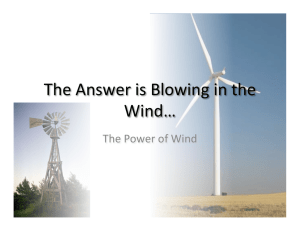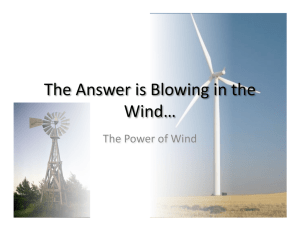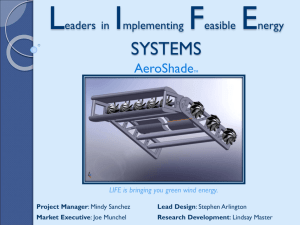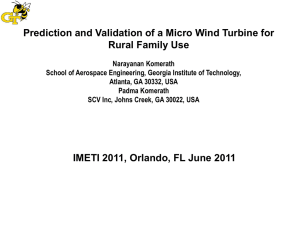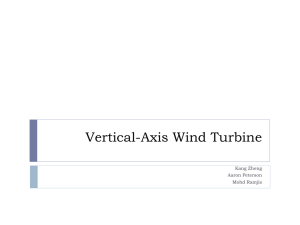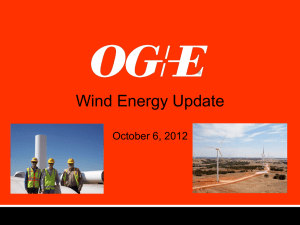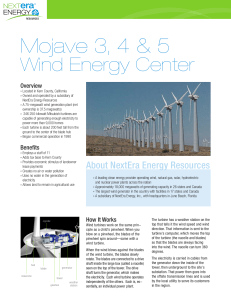The Answer is Blowing in the Wind*
advertisement
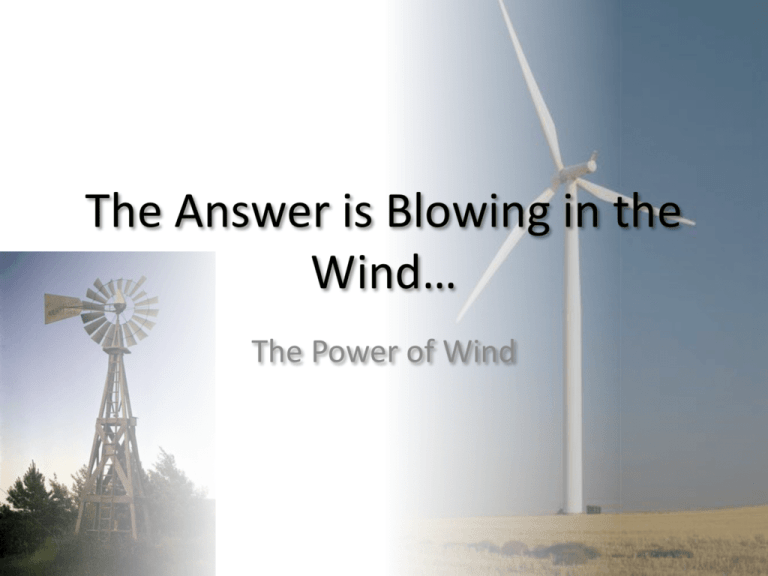
The Answer is Blowing in the Wind… The Power of Wind Disclaimer aerospace • I am not a wind expert!! Wind turbine blade on I-29 north of Sioux Falls, 10 Oct 2008 What is a Wind Turbine • Remember your bicycle dynamo? A turbine uses wind to turn shaft connected to a gearbox, followed by a generator to produce electricity How does a turbine work? Limits to 100 % Efficiency • Power in the wind • Betz limit (air can not be slowed to zero) • 59.7 % is maximum efficiency • Low speed losses - wake rotation • Drag losses – aerodynamics and blade geometry • Generator and drive train inefficiencies The Betz limit • Albert Betz, a German physicist, concluded that a wind turbine can convert no more than 59.3% of the kinetic energy of the wind into mechanical energy turning a rotor (1919) • For a wind turbine to be 100% efficient it would need to stop 100% of the wind – This would be a solid, flat disk and have no kinetic energy vs. Wind Power…Power of the Wind • Power in the wind =½AV3 • Subject to: – Effect of air density, – Effect of sweep area, A – Effect of wind speed, V – Swept Area, A = πR2 • Area of the circle swept by the rotor. Kinetic Energy = Work = ½mV2 R R The Importance of • Wind speed is the most • • • important factor in determining power Power is a cubic function of wind speed: V X V X V 20% increase in wind speed means 73% more power Doubling wind speed means 8 times more power d V 3 Windspeed Kinetic Energy = Work = ½mV2 Power = Work / t = Kinetic Energy / t = ½mV2 / t = ½(ρAd)V2/t Redistribute: = ½ρAV2(d/t) = ½ρAV3 Power = ½ρAV3 Power of the wind turbine • Power = ½ρAV3, but power of the turbine: • Powerturbine= Cp½ρAV3 – Cp = Power coefficient – Cp is the percentage of potential power converted to actual power • Limited by several factors • A 1MW turbine with a 30% Cp produces ~2,600 MWh that can power 320 homes An Working Example • Wind blows at 7 MPH = 3 m/s Power = • = 1.6 kg/m3 • Blade length = 50 cm → area = 0.785 m2 ( ) ½ρAV3 3 3 2 1 Power = 2 (1.6 kg /m )(0.785 m )(3m /s) Newton 3 2 3 3 1 = 2 (1.6 kg /m )(0.785 m )( 27 m /s ) ( ) = 16.95kg m /s = 16.95( kg m /s 2 3 = 16.95(N - m )/s = 16.95 Watts 2 )( m /s) How good does it get? • After engineering requirements, the real world limit is well below the Betz Limit with values of 0.35-0.45 • After inefficiencies in the generator, bearings, power transmission, etc. only 10-30% of the power of the wind is ever actually converted into usable electricity. An efficiency calculation Power of the wind (watts) = ½ ρ⋅A⋅V3 æ power out ö % efficiency, h = ç ÷ ´100 è power in ø Wind turbine parameters: Sweep area = 4 m2 Wind speed = 5 m/sec Power output = 90 watts æ ö 90 watts ÷ % efficiency, h = ç 3 ´100 3 2 ç 0.597 ´ 1 ´ 1.6 kg/m ´ 4m ´ (5 m/s) ÷ è ø 2 æ 90 wattsout ö = ç ÷ ´ 100 è 238.8 watts in ø % efficiency = (0.376) ´100 = 37.6 % Factor in Betz limit Actual efficiency = 22.5 % The Beaufort Scale • Gauging wind speed Wind Speed Distribution • Average speed does not denote maximum • Short bursts power carry V3 more power Weibull distribution http://www.ceere.org/rerl/about_wind/RERL_Fact_Sheet_1_Wind_Technology.pdf Modern Windmill Styles Vertical Axis • Smaller footprint • Urban use • Subject to low windspeeds Darrieus-style Horizontal Axis • High power output • Large foot Wind….it’s a Drag • Goal: Maximize lift-to-drag ratio Relies on wind force only Uses aerodynamics of lift http://science.howstuffworks.com/wind-power3.htm Blade Aerodynamics Lift • Angle of attack (pitch) needs to be 10-15° to get a high enough lift-to-drag ratio (> 10) Drag nasa.gov Blade Design 101 • A balancing act to keep drag, wind resistance, tip vortices, etc. to a minimum while simultaneously putting enough blade in the wind to capture it’s kinetic energy. • Good blade design has: – Smooth surfaces – Tapered edges – Sharp tail edge – Low thickness-to-length ration Blade Design 101 • A balancing act to keep drag, wind resistance, tip vortices, etc. to a minimum while simultaneously putting enough blade in the wind to capture it’s kinetic energy. Low angle of attack Medium angle of attack (10-15°) High angle of attack (> 20°) Solidity, Speed, and Torque Low solidity (0.10) = low speed, high torque Solidity = 3a/A R a = total area of blades A = sweep area of blades High solidity (>0.80) = high speed, low torque How high does the Windmill need to be? • Tower height of 30 feet wind power increased by 0 % • Tower height of 60 feet wind power increased by 41% • Tower height of 90 feet wind power increased by 75% • Tower height of 120 feet wind power increased by 100 % • Tower height of 150 feet wind power increased by 124% U.S. DOE Those blades look slow?!? • Turbines usually operate at 30 – 60 RPMs • Standard US electricity functions on 60 Hz AC power – This amounts to a sinusoidal curve flipping from +1 to -1 60 times per second – With a direct connection from blades to generator, the blades would have to spin at 1200-1800 RPMs (20-30 rev per second) – This is roughly 2x the speed of sound • Gearboxes are the key! – Gear ratios can increase hub speed while keeping the blades turning at a moderate pace – Ratios are typically 1:50 – Blade rotations ~30 RPM Tip Speed Ratio, λ = tip speed/wind speed • Tip speed = 2πr/t (distance/time) • Tip speed ratio is key to good blade design – If blades are too slow, a lot of wind is “missed” – If blades are too fast, the turbine acts like a solid disk • The perfect tip speed is determined to be: 4π/n, n is the number of blades • For 3 blades, the optimal TSR is 4.18 – Knowing the average windspeed for an site, the best TSR can be calculated – Adjustments in RPM can be made (speed) by increasing/decreasing load on the turbine in design Blade Size and Sound http://www.awea.org http://www.omafra.gov.on.ca Sound decreases by -6 dB on doubling distance noise Noise NOISE!!! • Large wind turbines have a maximum sound level of 60-70 dB • Background noise of an office environment • Most turbine noise is imperceptible at distances > 120m • Noise is a human perception U.S. Wind Energy Map Current Wind Capacity http://www.awea.org/pubs/factsheets/Market_Update_Factsheet.pdf Wind Capacity by State Texas Iowa California Minnesota Washington Oregon New York Colorado Kansas Illinois Oklahoma Wyoming North Dakota Indiana New Mexico Wisconsin Pennsylvania West Virginia Montana South Dakota Missouri Nebraska Idaho Michigan Maine Hawaii Tennessee New Hampshire Utah New Jersey Ohio Vermont Massachusetts Alaska Rhode Island Planned State Capacity 0 1000 2000 3000 4000 5000 Capacity (MW) Total US capacity: >20,000 mW (as of 9/2008) 6000 7000 8000 9000 Data compiled from NWEA Sites with More Information • KidWind Project: www.kidwind.org • Danish Wind Industry: http://www.windpower.org/en/tour.htm • American Wind Energy Association: http://www.awea.org/ • The U.S. Department of Energy: http://www1.eere.energy.gov/windandhydro/ • Wind turbine noise and perception: http://www.windpoweringamerica.gov/pdfs/workshops/ mwwg_turbine_noise.pdf


